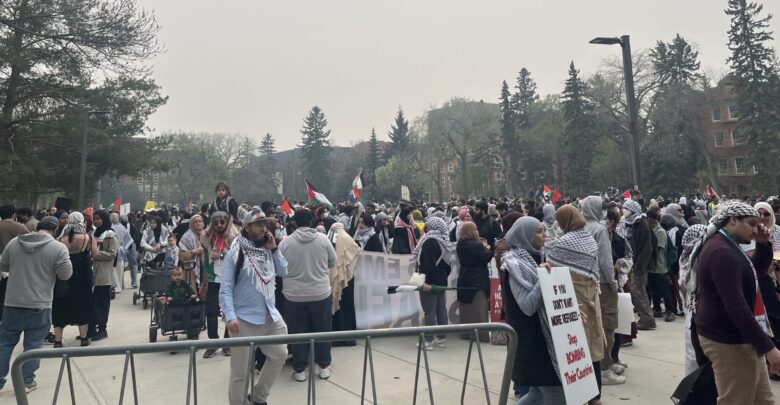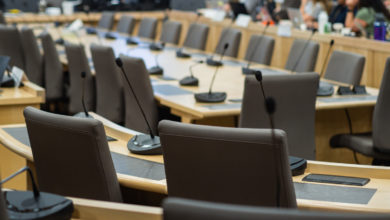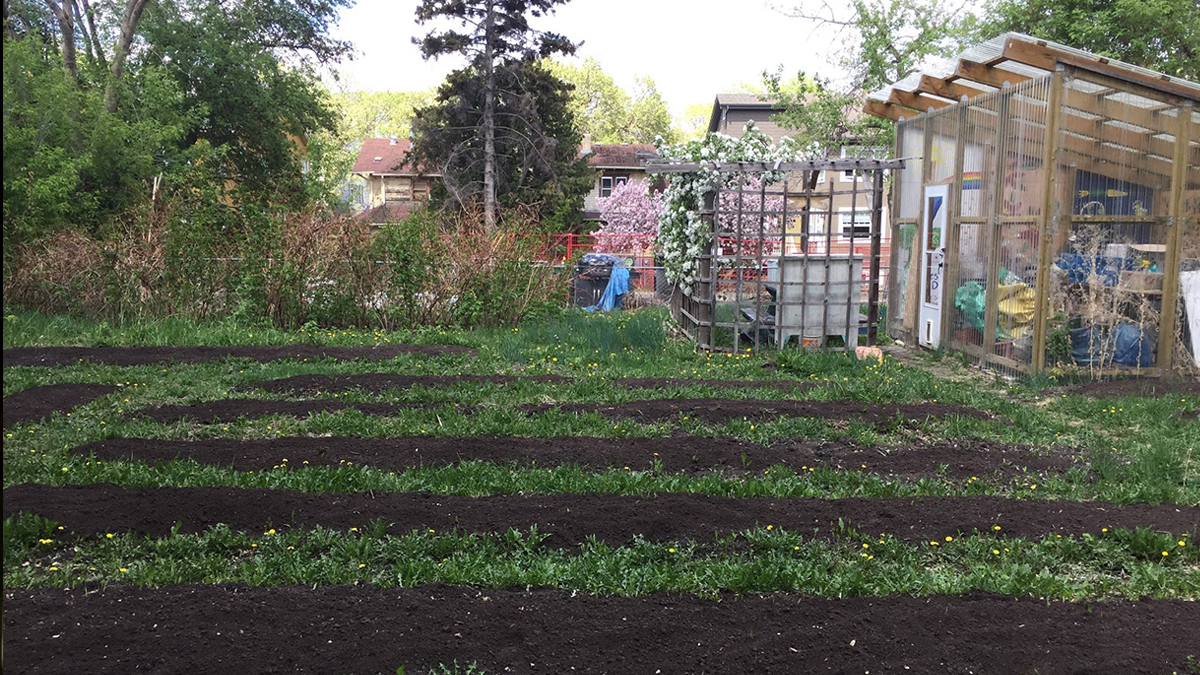Protesters march to U of A Main Quad, begin indefinite sit-in
The March for Palestine and sit-in follow the dispersal of a Palestine solidarity encampment at the U of A by Edmonton Police Services.
 Leah Hennig
Leah HennigOn May 11 at 12:00 p.m., a March for Palestine of hundreds of people began at Violet King Henry Plaza and ended at the University of Alberta Main Quad. This comes after the Edmonton Police Service (EPS) took down an encampment on Main Quad that same day.
The encampment was organized by the People’s University for Palestine YEG. Following the dispersal of the encampment by an EPS public safety unit team, U of A President and Vice-chancellor Bill Flanagan put out a statement. In this statement he said “almost all of the occupants of the encampment peacefully dispersed.”
In a statement released by the People’s University for Palestine YEG on May 11, they said “the U of A’s claim that students were removed peacefully is misleading, as eyewitness accounts and video evidence attest to the hostile and coercive tactics used by the public safety unit team.”
According to the statement, “four students sustained injuries of various degrees, including one that required hospitalization after being found on the ground in a neighbourhood near campus.” EPS deployed tear gas and pepper bullets and used bicycles and batons against the protesters, the statement also said.
Protesters speak about their experience with EPS during the encampment dispersal
Upon the march arriving at Main Quad, an unnamed speaker who was present at the encampment when EPS arrived at 4:30 a.m. spoke about the protesters’ experiences.
According to the speaker, EPS beat students, ripped apart tents, and threw the encampment’s chairs. Observers who were recording the dispersal were told by U of A Protective Services (UAPS) that they were permanently banned from the premises, the speaker said.
On May 11, U of A media relations told The Gateway in an email that “no members of the U of A community who were involved in the May 9 – 11 encampment have been banned from campus and no students were suspended.”
The speaker said EPS began to push protesters and observers towards Saskatchewan Drive Northwest, behind the Centennial Centre for Interdisciplinary Science (CCIS). At this time, EPS began arresting protesters, the speaker said.
“I want you to imagine that that is only an ounce of what the people in Gaza feel every day. What the people of Palestine have been dealing with for the last 76 years,” they said.
The protesters played a recording of the encampment when it was dispersed. In the recording EPS officers could be heard chanting “move” and protesters screaming.
The speaker then demanded the resignation of Flanagan.
“He has not helped students, he has hidden from students,” she said. “He remains silent despite calls for months and months from his students, faculty, and community. And now, he set EPS on his students.”
The speakers invited one of the encampment protesters to give a personal testimony. The protester was present at the encampment for both days. His leg was injured after it was hit by an EPS baton, the injured protester said.
“What we need is numbers like this. We need to build this movement on this campus, on every campus, in the streets,” he said.
Following the speeches, some protesters began an indefinite sit-in. Some protesters also began a communal prayer.
“They tried to shut us down. It’s just made us stronger and firmer in our beliefs and in our cause,” media spokesperson says.
The Gateway spoke with Nour Salhi, a media spokesperson for People’s University for Palestine YEG. According to Salhi, among the protesters there is a “sense of encouragement.”
“They tried to take us down, they tried to shut us down. It’s just made us stronger and firmer in our beliefs and in our cause.”
Although the encampment was dismantled, Salhi said they are still urging the U of A and MacEwan University to hear out their demands and speak with them. On May 9, the first day of the encampment, Flanagan released a statement in which he said “university leadership is in open and ongoing communication with this group.”
In the statement the People’s University for Palestine YEG posted on May 11, they wrote “at no point since the encampment was initiated on May 9 did the university or [Flanagan] establish an open line of communication with our encampment.”
“When you say you’re opening a channel of communication … we do not count security or campus cops giving us notices as open and ongoing communication,” Salhi said.
According to Salhi, the People’s University for Palestine YEG would like the U of A Students’ Union (UASU) to issue a statement of support and condemn the actions of university administration.
“We would like them to work with us to fulfill our demands. We want to make allies, not enemies, and that’s clearly not being received. The UASU can really help with that.”
The Gateway briefly spoke to UASU President Lisa Glock. Glock said she doesn’t appreciate EPS’ use of force. The UASU is in communication with the university and is trying to gather information from them, Glock said.
Main Quad closed from 11:00 p.m to 6:00 a.m according to peace officers
At 11:00 p.m. on May 11, the sit-in dispersed from Main Quad. Around 20 people continue to participate after 9:00 p.m..
Two peace officers observed the sit-in from a patrol car, and gave a warning to protestors at 9:54 p.m that Main Quad would close at 11:00 p.m..
The peace officers told The Gateway that “sitting around and doing this all night isn’t going to be permitted,” and the new closure times came from the clearing of the encampment earlier that day.
When asked who implemented the closure times, one peace officer said “it’s just messaging we’re told to deliver.”
— With files from Leah Hennig and Lily Polenchuk
UPDATE: This article was updated at 12:44 p.m. on May 12 to reflect the time the sit-in ended and new information about Main Quad being closed from 11:00 p.m. to 6:00 a.m..




